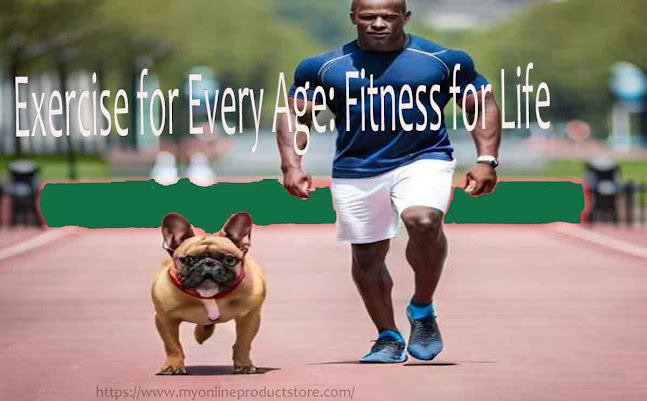Exercise is not just a way to stay in shape; it's a vital component of a healthy and fulfilling life at every age. Whether you're a child, a young adult, in your middle years, or a senior, regular physical activity offers numerous physical, mental, and emotional benefits. In this comprehensive guide, "Exercise for Every Age: Fitness for Life," we will explore the importance of exercise at various life stages, provide tailored fitness tips, and address common questions and concerns related to staying active throughout your life. By the end of this article, you'll be inspired to make exercise a lifelong commitment to health and well-being.
The Benefits of Exercise at Every Age
Physical activity provides a wide range of benefits that extend to all stages of life:
1. Childhood (Ages 2-12)
- Physical Development: Exercise supports the development of motor skills, coordination, and muscle strength in children.
- Mental Health: Physical activity can improve concentration, mood, and cognitive function in school-aged children.
- Healthy Habits: Establishing an active lifestyle early in life sets the foundation for lifelong fitness habits.
2. Adolescence and Young Adulthood (Ages 13-29)
- Fitness and Strength: Regular exercise enhances physical fitness, endurance, and muscle development during adolescence and young adulthood.
- Stress Relief: Physical activity is a natural stress reliever, helping young adults manage the challenges of school, work, and social life.
- Weight Management: Exercise is crucial for maintaining a healthy weight during the transition from adolescence to adulthood.
3. Adulthood (Ages 30-64)
- Heart Health: Regular exercise reduces the risk of heart disease, hypertension, and other chronic conditions.
- Bone Health: Weight-bearing activities like walking and strength training help maintain strong bones.
- Mental Well-Being: Exercise can alleviate stress, anxiety, and depression, promoting overall mental health.
4. Senior Years (Ages 65+)
- Mobility: Staying active helps seniors maintain mobility, balance, and independence.
- Chronic Disease Management: Exercise can aid in managing chronic conditions like diabetes, arthritis, and osteoporosis.
- Social Interaction: Group fitness activities provide social engagement and support.
Tailored Fitness Tips for Every Age
1. Childhood (Ages 2-12)
- Encourage unstructured playtime that involves running, jumping, and climbing.
- Limit screen time and promote outdoor activities.
- Make exercise fun through games, sports, and family activities.
2. Adolescence and Young Adulthood (Ages 13-29)
- Find activities you enjoy, whether it's team sports, dancing, or fitness classes.
- Aim for 150 minutes or more per week of moderate-intensity aerobic exercise.
- Include strength training to build muscle and bone density.
3. Adulthood (Ages 30-64)
- Incorporate exercise into your daily routine, such as walking or biking to work.
- Mix cardio workouts with strength training and flexibility exercises.
- Listen to your body and adapt your exercise routine as needed.
4. Senior Years (Ages 65+)
- Engage in low-impact activities like walking, swimming, or tai chi.
- Work on balance and flexibility to prevent falls.
- Consult with a healthcare provider before starting a new exercise program, especially if you have chronic health conditions.
Common Exercise FAQs
Q: How much exercise should I get per week?
A: Adults should aim for at least 150 minutes of moderate-intensity aerobic activity or 75 minutes of vigorous-intensity activity per week, along with muscle-strengthening activities on two or more days.
Q: Is it safe to exercise as a senior with chronic health conditions?
A: In most cases, exercise is safe and beneficial for seniors with chronic conditions. However, it's crucial to consult with a healthcare provider to develop a personalized exercise plan.
Q: Can I exercise if I'm overweight or obese?
A: Absolutely. Exercise can be adapted to all fitness levels and body sizes. Low-impact exercises should be your first choice, and you can progressively up the intensity as you get more comfortable.
Q: What are some strategies for maintaining workout motivation?
A: Find activities you enjoy, set achievable goals, and vary your routine to keep it interesting. For more incentive, think about working out with a buddy or hiring a personal trainer.Q: Is it ever too late to begin working out
A: No, it's never too late to start. Exercise can provide benefits at any age and can help improve overall health and well-being.Conclusion
Exercise is a lifelong journey that offers benefits at every stage of life. Regardless of your age, incorporating physical activity into your daily routine can enhance your physical health, boost your mood, and improve your quality of life. Whether you're a child, a young adult, in your middle years, or a senior, there are tailored fitness tips and activities that can help you stay active and vibrant. Remember that the key to fitness for life is finding activities you enjoy and making exercise a sustainable part of your daily routine.












Post a Comment
Post a Comment